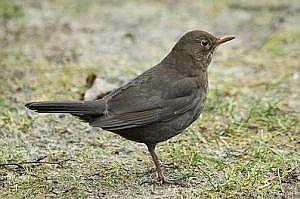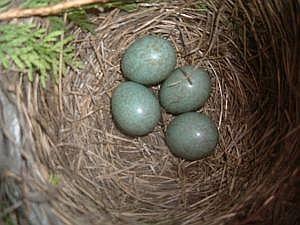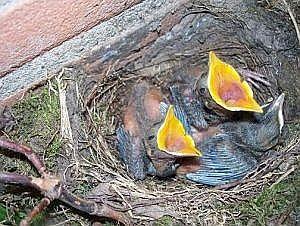
When the soul listens,
it speaks a language that lives
and softly whispers,
making itself heard.
Guido Gezelle
Concluding or enriching the concepts
General
The first time you find a concept for something that you have observed, it is very satisfying. Now you know what you have observed. The first time that you identify a blackbird is a momentous occasion: you know what you've seen. This feeling stays with you for a while, but if you don't make any new discoveries you'll find yourself thinking, “Gee, another blackbird”, and finally, “Oh, just another blackbird.” Your interest flags when you don't make any new observations. You stop observing because you have found a concept to tag onto the phenomenon, and that is sufficient for you. The concept itself, however, is not very fleshed out.
In many cases, it does not matter that we do not investigate something more deeply. This applies particularly to man-made technical objects. If you need to catch a bus, it's enough to know that you need a yellow bus. For most passengers, all the other aspects that make a bus a bus are not relevant. You don't pay attention until the bus company changes the colour of the bus to green or red.
In other cases, such as with living organisms and works of art, it is evident that accepting a concept as fixed does injustice to what you observed. This is so for a blackbird, but more so for someone you know. Do you regard her as “just Maria”, day after day, or are you interested in her, in who she is and how she is feeling today? Clearly, then, being aware of your interest and attitude is important, because it has major consequences for how we regard each other and deal with each other.
When “oh, it's just Maria,” or “oh, just another blackbird” is good enough for you, then you reduce your view of Maria or the blackbird to a fixed standard, your interest in them fades, you fail to note changes and you find yourself living in a world of standard objects.
Species or type
You could also see a concept as a box that you can fill with observations. You can make countless observations of blackbirds. You might notice right away that the females are almost uniformly brown, thus differing in colour from the males. Later, you might see the male holding a worm in his beak, or note that he sings a particular song in the evenings as he balances on the eaves, that he chases away other males in spring, that their chicks hatch quite early in spring, that his song is melancholy, and so on. You can see a lot when you're paying attention and refraining from drawing conclusions. You can make many observations of every organism, all of which you can include in the concept. In other words, you are observing many different aspects of a blackbird and thus getting to know it better, or rather getting to know the species blackbird better.
It is interesting to note that most people start by distinguishing the different types or species, which may then lead to curiosity about other aspects, such as behaviour, diet, habitat, the time of year that they appear, how the species can be conserved, and so on.
This is a general rule: interest and attention always reveal new worlds of knowledge and concepts. In contrast with the earlier example in which the concept acquired a fixed, standard meaning, new observations expand the concept of a blackbird and make it richer in meaning. This makes your surroundings more interesting, because there is always something new to be discovered.
Individual
You can observe a species or type, but of course you can also observe an individual. If you were to observe a pair of blackbirds nesting in your garden, you would soon pick up all sorts of behaviour that is unique to this pair. Naturally, there is a basic repertoire that all nesting blackbirds follow, but each pair does these things in its own way.
Perhaps this is easier to observe in trees and plants. An oak is an oak, but the oak in your park is just a little bit different from all the other oaks. And after a while, you'll be able to distinguish it from the others. Each tree, each organism, has general and individual characteristics. By observing both, you can expand and enrich your concept of the individual organism.
The following example is a variation on this theme. You are standing in front of an apple tree, and on the side facing you are lots of red apples. You automatically assume that the other side of the tree will also be laden with red apples. When you walk around the tree to take a look, however, you notice that the apples are more yellow than you'd expected. That side of the tree has had less sun.
Most of the objects that we see are three-dimensional, and we cannot encompass them with just one look. If we want to see the object in its entirety, we have to look at it from different angles. You have to make several observations of the same individual object. Now, however, you are not studying the different aspects, but observing the object from different angles. Observations regarding the type or species and regarding the individual enhance each other. Observations of the species adds perspective to your observations of that particular bird or that specific tree.
Conversely, the concept of the species is based on observations of countless individuals, and the more of these observations there are, the richer the concept and the more accurately it reflects the true characteristics of the species.
In summary, there are three possibilities:
• you are satisfied just having the concept, your interest fades;
• you seek species characteristics; or
• you seek individual characteristics.
A cow's a cow (you know enough, your interest fades). There are different breeds of cattle, and farmers have herds made up of animals from a particular breed (you seek species characteristics), and the herd is more or less adapted to conditions on the farm and to the farmer's personality, and each cow in the herd is different (you seek individual characteristics).
Focus
Each of the aspects that you can see a blackbird, can become a focus. You can look at the shape of the beak of all birds you see, or to the food they eat, or what kind of nest they build, the color of the eggs, etc. In another species you notice something that you did never see a blackbird do. So you can go back and forth. It helps to see the differences and to characterize them better. Especially in a new or confusing situation it helps to make an observation for a short time into a focus.
This example can be expanded with many others. If we look at various trees and shrubs, then we can notice that the leaves of a hazel are scattered and of the privet opposite. We can then ask how other shrubs and bushes do their branching and watch to this.
Consequences
If you are easily contented as soon as you have a tag for something, or if you supplement your observations only with general knowledge and laws, you will miss the rich substance of your observations. You will restricted to banalities such as “birds hatch their eggs”, “birds fly”, and so on. The more you think in fixed concepts and structures, the less interested you become in what is really going on. You stop looking and dampen your enthusiasm so that it cannot remark on new things. You become jaded. The image that you have of something does not have to agree with what is actually before you. Eventually, a mere glance will be enough for you to see what you wanted know. If you observe like this (which isn't really observing at all), you will find yourself more and more removed from the world, and you will find connecting with it increasingly difficult.
You may think you know the world, because you know its laws. But you will lose knowledge of the special things, because you have stopped looking for them. You may end up using objects or organisms as you please, simply because you feel no connection with them, nor do you have any desire for this. There are numerous examples of this attitude in modern agriculture.
There are many cases in which a limited observation is supplemented with general observations or knowledge. This leads you to a conclusion which might not be in line with reality. If you want to examine the different aspects of an object, you must take more time for your observations and connect your observations to make a coherent concept. Only then will your notion more accurately reflect reality. When you treat cows on the basis of their being “just cows”, you are using a general barebones concept of cow. You start becoming a bit more specific by taking account of breed. But you can resolve selection, diet and management problems most effectively if you take account of the specific characteristics of the herd, or better yet, the individual animal.
Sometimes, cows in a herd wound each other with their horns. That might be all a farmer sees; he might not see the connection between the digestive system of ungulates and their horns, and might decide simply to remove those nasty horns without any concern for consequences he hasn't looked into.

Gee, another blackbird?

Nest of a blackbird with blue eggs

Fledglings of a blackbird

Branching of plants
Exercises
Search your memory for three examples of dealing with a concept. Share these memories in a small group. Can you discover any patterns? For example, the point that your interest always faded, or the cases in which your interest stayed focused on species/type, and those in which you stayed focused on the individual?
Find examples of automatic, standardised ways to deal with things and examples of continuous observation. Can you determine the consequences of each? Share your ideas in a group. Can you discover any patterns?
Take a three-dimensional object. Observe it from one angle and imagine what the other side might be like. Then look at the other side and describe the differences. In order to learn more effectively, we recommend that you draw or model each step: the front of the object, the imagined back of it, and finally the observed back.
An alternative exercise for a group: a composite three-dimensional object is placed in the middle of the room under a sheet. The participants come in and stand at tables placed around the object. The sheet is removed, and each person makes a clay model of the object from their particular perspective. They must imagine what the other, as yet unseen, sides of the object look like. They may look at what their neighbours are doing, so that they can get an indication of what the object looks like from other angles. The participants must also try to connect their image of the left side of the object and of the right side. When everyone is finished, they can walk around the object and find out whether or not they had an accurate notion of the sides that they could not see.
Make an observation of the lengthwise growth of a plant. Measure the internodal distance, the distance between the leaves. Then measure the internodal distances of plants in other situations (sandy soil, clay, sunny, shady), or compare the internodal lengths of different plant species. Internodal length is a focus. What do you learn from this exercise?
